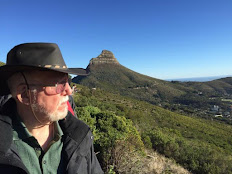 At the annual meeting of the Friends of the Land of Keweenaw (FOLK) in October 2008 in Baraga, Teresa Bertossi, public outreach coordinator for Save the Wild UP (SWUP), presents an overview of the potential threat to the Lake Superior watershed posed by Kennecott-Rio Tinto's proposed Eagle Project for sulfide mining near Marquette. "We're mostly concerned about acid mine drainage," Bertossi said. SWUP members introduced the first issue (November/December 2008) of their new publication, The Splash at the FOLK meeting. (Photo © 2008 Michele Bourdieu)
At the annual meeting of the Friends of the Land of Keweenaw (FOLK) in October 2008 in Baraga, Teresa Bertossi, public outreach coordinator for Save the Wild UP (SWUP), presents an overview of the potential threat to the Lake Superior watershed posed by Kennecott-Rio Tinto's proposed Eagle Project for sulfide mining near Marquette. "We're mostly concerned about acid mine drainage," Bertossi said. SWUP members introduced the first issue (November/December 2008) of their new publication, The Splash at the FOLK meeting. (Photo © 2008 Michele Bourdieu)MARQUETTE -- Save the Wild UP (SWUP), a non-profit group organized to inform the public about the risks of uranium and metallic sulfide mining, now publishes The Splash, a newsletter inserted in the free Marquette Monthly publication and also on line through the SWUP Web site. The recent January/February 2009 issue (No. 2) of The Splash (in the January 2009 Marquette Monthly) offers updates on Kennecott-Rio Tinto's proposed sulfide mine -- its "Eagle Project" -- for the Yellow Dog Plains near Marquette as well as articles about similar mining issues on public lands in Utah and on Native American reservations in Minnesota and Ontario.*
In this issue of The Splash, an article titled "Kennecott, Buying Hearts for the Mine in Marquette County," tells how Kennecott has been encouraging township and county officials to support the mining proposal because of supposed economic benefits. A few years ago some of these local government officials had requested an independent hydrologic survey of the Yellow Dog Plains and had written to Governor Granholm about their concern that sulfide mining threatens drinkable, fishable water in Michigan.
However, more recently, according to the article, Eagle Project Manager Jon Cherry has been working with Marquette County Administrator Steven Powers and Lake Superior Community Partnership (LSCP) CEO Amy Clickner on "an agreement between the county, townships and Kennecott, focusing on organizing economic projects and increasing the county's tax base." **
Another article, "Public Land Threatened Yet Again," concerns Kennecott's prospecting on two large public recreation areas in Salt Lake County, Utah. In 2007, while this county was in the process of purchasing the 1,700 acre Rose Canyon Ranch -- used for hiking, biking and horseback riding -- for $8.7 million, Kennecott filed 70 mining claims on the property, based on the fact that the federal government, not the landowner, owns the subsurface mineral rights and on the 1872 Mining Law that, according to this article, allows "any person or corporation to trespass, prospect, file a mining claim and a plan for a mining operation without the landowner's permission."
 Scott Bouma, right, SWUP research and technology specialist, speaks on mineral rights at the October 2008 FOLK meeting. "If you don't know who owns your mineral rights, research it," Bouma advised. Also pictured are SWUP's Teresa Bertossi and Chuck Brumleve, geologist working with the Keweenaw Bay Indian Community (KBIC), one of the groups involved in a contested case against the Michigan Department of Environmental Quality (DEQ) for granting mining permits to Kennecott. (Photo © 2008 Michele Bourdieu)
Scott Bouma, right, SWUP research and technology specialist, speaks on mineral rights at the October 2008 FOLK meeting. "If you don't know who owns your mineral rights, research it," Bouma advised. Also pictured are SWUP's Teresa Bertossi and Chuck Brumleve, geologist working with the Keweenaw Bay Indian Community (KBIC), one of the groups involved in a contested case against the Michigan Department of Environmental Quality (DEQ) for granting mining permits to Kennecott. (Photo © 2008 Michele Bourdieu)While Salt Lake County has petitioned the Bureau of Land Management for mineral rights to prevent future mining exploration, Kennecott announced they would begin prospecting in Yellow Fork Canyon, another county-owned recreation area. The article notes Kennecott owns and operates the nearby Bingham Canyon Mine, "considered the second most toxic active mining operation in the United States."
This article also draws a parallel between Kennecott's actions in Utah and its projects in Michigan's Upper Peninsula.
Kennecott's surface use lease on 120 acres of public land on the Yellow Dog Plains includes Eagle Rock, a site considered sacred to the Keweenaw Bay Indian Community (KBIC). The article notes a double standard on the part of the State of Michigan: The Michigan Department of Natural Resources (DNR) has denied KBIC's application for a land use permit to continue using Eagle Rock for traditional ceremonies because they may "'conflict with other approved uses and activities in the vicinity.'" At the same time, the article concludes, "The DNR does not consider Kennecott's multi-decade lease (until 2042) to conflict with other uses, including public recreation and traditional ceremonial use ... or (the effect of that lease) on KBIC's internationally recognized treaty rights, considered the highest law of the land."
 Eagle Rock on the Yellow Dog Plains, a potential site for Kennecott Minerals' proposed Eagle Project sulfide mine, is a sacred site for the Keweenaw Bay Indian Community. (Keweenw Now file photo © 2007 Sue Ellen Kingsley)
Eagle Rock on the Yellow Dog Plains, a potential site for Kennecott Minerals' proposed Eagle Project sulfide mine, is a sacred site for the Keweenaw Bay Indian Community. (Keweenw Now file photo © 2007 Sue Ellen Kingsley)An article on efforts of First Nation activists in Ontario, "Community Unifies to Defend Their Rights: The Success of the KI6," also points out the problems that arise when outdated mining laws (e.g., Ontario's 1873 Mining Act), still in effect, fail to recognize Treaty rights of indigenous peoples.
An editorial in this latest issue of The Splash, "The Kennecott Eagle Story: Fact or Fiction?" is written by former miner Jack Parker of Houghton, who has degrees from Michigan Tech in mining and geological engineering and who has worked, unpaid, on research related to Kennecott's Eagle mine since April 2006. Parker gives examples of suppression of expert testimony on weaknesses in the Kennecott application for the sulfide mining permits. He points out how the Department of Environmental Quality (DEQ) and the DNR have ignored the omissions and deceptions in the application.
 In her presentation at the FOLK meeting, Teresa Bertossi projected these quotes from Stephen Chester, Michigan DEQ Director: "We simply don't have the kind of funding we need to adequately implement the laws we're required to implement....The bottom line is we simply don't have the resources to get out and inspect all of these facilities ... in some cases we'll have to rely on people's honesty and integrity."
In her presentation at the FOLK meeting, Teresa Bertossi projected these quotes from Stephen Chester, Michigan DEQ Director: "We simply don't have the kind of funding we need to adequately implement the laws we're required to implement....The bottom line is we simply don't have the resources to get out and inspect all of these facilities ... in some cases we'll have to rely on people's honesty and integrity."* Read these and other articles on mining in the Jan./Feb. 2009 issue of The Splash on line.
**See the Dec. 8, 2008, article, "Humboldt Township Board Lends Kennecott Support," on Save the Wild UP's Web site.
Other updates from Save the Wild UP
Matt Johnson, former director of Governor Granholm's Office for the Upper Peninsula, has resigned from his post and now works for Rio Tinto, the parent company of Kennecott Minerals, according to a November 2008 article by Gabriel Caplett of Save the Wild UP.
"Johnson is now involved with government relations for the company. Prior to working in the Governor’s office, Johnson was Congressman Bart Stupak’s Upper Peninsula district administrator," Caplett writes.
He notes Johnson was formerly the Governor’s contact on metallic sulfide mining in the UP and assisted in coordinating the Governor’s involvement in the formation of Michigan’s new nonferrous metallic mining laws. He kept her informed on updates from the DEQ, the company and citizens, including "contentious issues related to Kennecott’s project."
In this article on Johnson's new role as lobbyist for Kennecott, Caplett refers to statements by Joe Maki, a geologist with the Department of Environmental Quality (DEQ), who testified at a recent contested case brought against the DEQ by opponents of Kennecott's Eagle Project -- the National Wildlife Federation, the Huron Mountain Club, the Keweenaw Bay Indian Community and the Yellow Dog Watershed Preserve.
Maki "acknowledged that the DEQ did not apply a central tenet of Michigan’s metallic mining law in considering Kennecott’s application," Caplett states. "Maki affirmed that neither he, nor his mining team, required Kennecott to provide a mine plan that 'reasonably minimizes actual or potential adverse impacts on air, water and other natural resources,' a legal requirement."***
Another SWUP article by Gabriel Caplett, "Aquila Representative Faces Criticism at Public Meeting," cites critical reactions to a presentation on acid mine drainage given in Menominee, Mich., by Aquila Resources, the Canadian junior mining exploration company that recently sold its Humboldt Mill facility to Kennecott-Rio Tinto. Aquila also supplied Kennecott with state mineral leases for the proposed Eagle Project mine over a decade ago.****
On Dec. 16, 2008, SWUP posted the following Expected Time Line for Major Decisions:
Mid-January or beyond -- EPA Draft decision on Kennecott-Rio Tinto's injection permit is expected. Public hearing dates will be announced at that time. Hearings are expected to be scheduled 60 days from the draft decision.
Mid-April -- USFWS (United States Fish and Wildlife Service) will announce whether or not the Coaster Brook Trout, found in streams that could be impacted by the Eagle Project, qualifies under the Endangered Species Protection Act. Read more on this issue and how it relates to the EPA decision ...
Anytime -- A recommendation is expected from the administrative law judge in Lansing, Richard A. Patterson, based on evidence and testimony presented by the National Wildlife Federation, Keweenaw Bay Indian Community and the Huron Mountain Club over the course of last summer. His recommendation is sent to Michigan DEQ Director Stephen Chester for a final decision.
February 12 -- Rio Tinto has announced that due to the sagging global economy, some of their projects, including Eagle, could be axed. Kennecott is proceeding into the future with caution.
*** Read the rest of this article on SavetheWildUP.org. More statements made by Joe Maki at the contested case hearing appear in Save the Wild UP's first issue of The Splash, (November-December 2008) available online.
**** Read about acid mine drainage, a by-product of the sulfide mining process, that pollutes thousands of miles of streams and rivers every year.
Editor's Note: See also Layla Aslani's Daily Mining Gazette article, "Controversial Kennecott Mine addressed," on Teresa Bertossi's presentation at the Oct. 23 FOLK meeting.

































































































































No comments:
Post a Comment